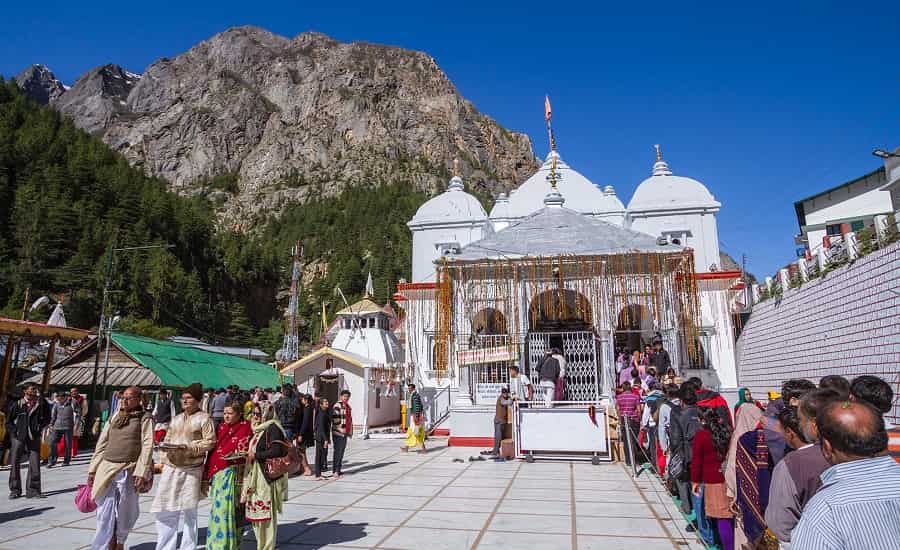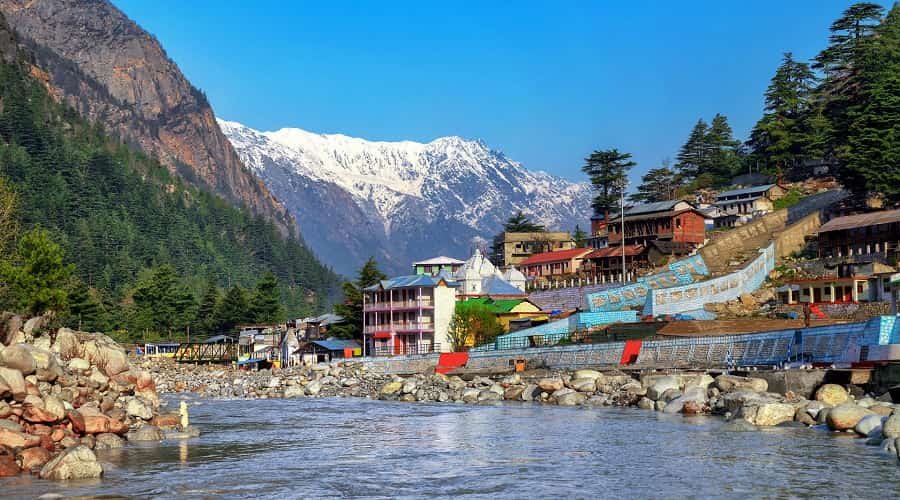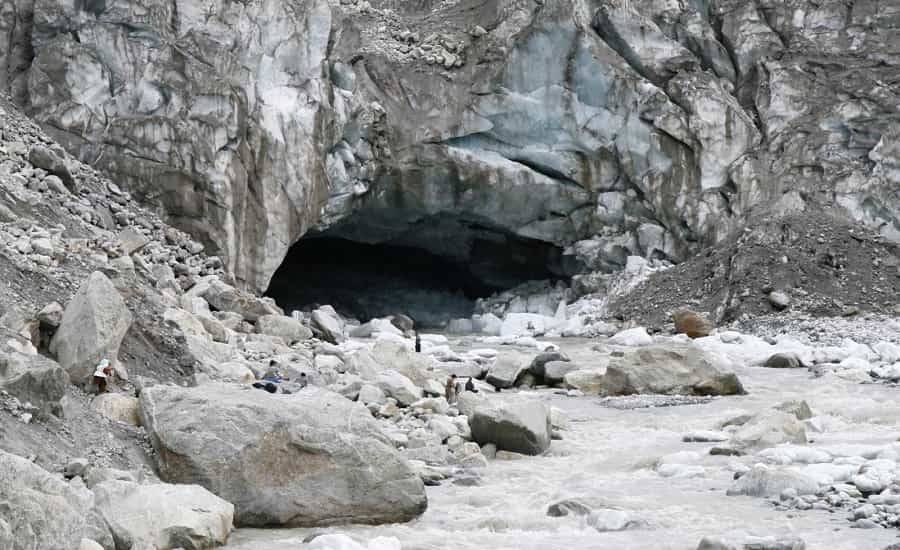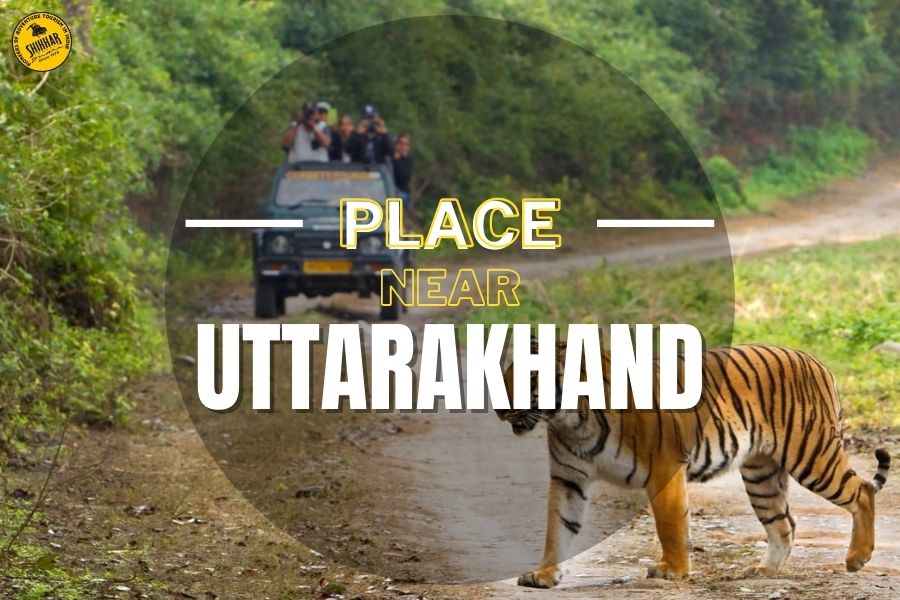It is located in Uttarakhand state of India and on river bank of Bhagirathi. It is regarded as scared temple of the goddess Ganga. This temple belongs to eighteen century and Amar Singh Thapa has built it. The “Shivling” that represents lord Shiva is present here and it is surrounded by the water of river Ganga. In the season of winters people can easily see the Shivling as the river water get frozen due to cold temperature.

Main Attraction
It offers scenic beauty to the people who visit this pilgrimage. You can encounter rugged terrains as well as gushing water that comes from the Bhagirathi which is one of the tributary of Ganga. Mountains that are covered with snow look beautiful and refresh the mind as well as soul of the viewer.
History
The Gangotri temple is said to be built by the Gurkha general Amar Singh Thapa in 18th century. The history says that a Yagna (worship with fire) was made by the King Sagar to betray his supremacy after defeating all the demons in the earth. To celebrate his victory he sent his horse for an peaceful journey around the earth accompanied by his 60,000 sons.
On the other side, Lord Indra, the supreme leader of all the deities, got afraid that, if the yagna made by the King Sagar gets succeed, then the power of King would divest off his heavenly throne. To prevent from achieving the Yagna, Lord Indra took away the horse and tied it in the ashram (a hermitage) of the Sage named Kapil, who was in a deep meditation.
When the 60,000 sons of King Sagar came in search of the horse, they found that the horse was in the hermitage of sage Kapil, and they started to attack the hermitage. The sage Kapil who was in the deep meditation got disturbed by them and in angry he cursed them to turn into ashes. And the sage said that they could be relieved from their sin only if the holy Ganga River touches their ashes. Due to the restless meditation by King Bhagirath (the grandson of King Sagar), towards Goddess Ganga, the daughter of heaven, the Goddess appeared in the form of a River to relieve them of their sin.
Weather
Since this place is quite near to Himalayas thus it has colder type of climate than other parts of India. From November to February there are cold winters and March to May the climate is quite warmer. June and July are the months of monsoon.

Fortes of Gangotri Temple
The Goddess Ganga, the daughter of heaven has been worshiped as the main deity of this temple. And there is a mythology that to control the massive effect of river Ganga, Lord Shiva took up the river into His matted locks. And then only by the worship of King Bhagirath towards Lord Shiva to get the blessings of Goddess Ganga, Lord Shiva released the river Ganga from His locks in seven streams.
The Seven Streams of River Ganga are:
- Bhagirathi
- Jahnvi
- Bhilangana
- Mandakini
- Rishiganga
- Saraswati
- Alaknanda
The special feature of the temple is that there is a natural Shiva lingam rock at Gangotri, which got submerged under the water. The particular place is considered as a place where Lord Shiva took His holy seat when river Ganga levitated in His matted locks. However, the place Gangotri is a renowned source of Goddess Ganga, the goddess is later came to be called as Goddess Bhagirathi. The rock on which the King Bhagirath is said to have meditated towards goddess Ganga is known as Bhagirath Shila, located inside the temple premises.
Poojas
The temple will be opened for only six months (between April and November), and during the rest of the period, the temple will be covered with snow.
Poojas during summer
- 15 a.m. to 2.00 p.m.
- 00 p.m. to 9.30 p.m.
Poojas during winter
- 45 a.m. to 2.00 p.m.
- 00 p.m. to 7.00 p.m.
Festivals
- Janmashtami – August or September
- Diwali – October or November
- Vijaya Dashami – September or October
Places to Visit in Gangotri
The religious and devotional place has many attractions which can mesmerize any human with the gorgeous and splendid beauty display of Mother Nature. A peaceful and serene destination with unparallel beauty makes Gangotri a favored tourist destination. Even for the adventure lovers there is good option for trekking and other games.

Gangotri Temple: This is one of the most important pilgrimage sites in India, dedicated to the goddess Ganges. Visitors can offer prayers at the temple and take a dip in the holy waters of the Ganges River.
Gaumukh Glacier: This is the source of the Ganges River, located approximately 18 km from Gangotri. Visitors can take a trek to the glacier and witness the majestic beauty of the Himalayas.
Bhairon Ghati: This is a scenic pass located near Gangotri, offering stunning views of the surrounding mountains and valleys. Visitors can take a trek to the pass and enjoy the breathtaking scenery.
Surya Kund: This is a hot spring located near Gangotri, believed to have medicinal properties. Visitors can take a dip in the hot springs and enjoy the natural beauty of the surrounding landscape.
Harsil Village: This is a small village located near Gangotri, known for its serene beauty and scenic views. Visitors can take a stroll through the village and enjoy the quaint charm of the local lifestyle.
Suggested Tour: Gaumukh Tapovan Trek
Best Time to Visit
In conclusion, the best time to visit Gangotri is from April to June and from September to November, when the weather is pleasant and ideal for sightseeing and outdoor activities. Visitors should avoid visiting during the monsoon season and winter months.
By Bus
- The state government provides the facility of regular buses for the tourist to visit the Gangotri easily.
By Train
- Uttarakhand railway station is the nearest place to reach Gangotri.
By Air
- Jolly grant is the name of the airport that is present in Dehradun and it is closest to Uttarakhand. From there people can hire private cab or taxi so as to reach Gangotri.
- Airport that is present in Pantnagar can be used to reach Gangotri as well.
Distance Chart
Here is a distance chart for Gangotri Dham, showing the approximate distances from some of the major cities and tourist destinations in the region:
- Dehradun: 250 km
- Rishikesh: 180 km
- Haridwar: 200 km
- Mussoorie: 270 km
- Yamunotri: 70 km
- Uttarkashi: 100 km
- Kedarnath: 240 km
- Badrinath: 350 km
- New Delhi: 460 km
- Agra: 620 km
This distance chart is only a rough estimate and actual distances may vary slightly depending on the mode of transportation and route taken. However, it provides a good idea of the approximate distances between Gangotri Dham and some of the major cities and tourist destinations in the region.
Route Map
Here is a general route map for Gangotri:
- From Delhi: Drive or take a train to Dehradun, then drive to Gangotri via Haridwar and Rishikesh.
- From Haridwar: Drive to Gangotri via Rishikesh.
- From Rishikesh: Drive to Gangotri.
- From Uttarkashi: Drive to Gangotri.
The exact route and mode of transportation may vary depending on the starting point and personal preference. Visitors can also opt to take a helicopter or a shared taxi to Gangotri, though this may be more expensive.
Regardless of the mode of transportation, the journey to Gangotri is scenic and offers breathtaking views of the Himalayas, making it a memorable experience for tourists.




1 Comment
Your sense of humor, combined with your knack for storytelling, makes every post a joy to read. Can’t wait for the next one!